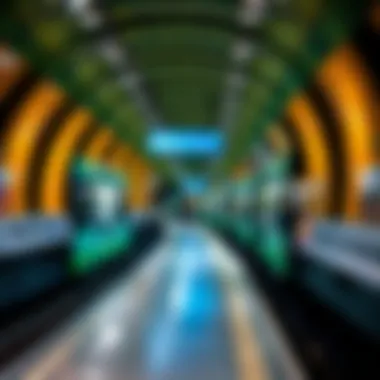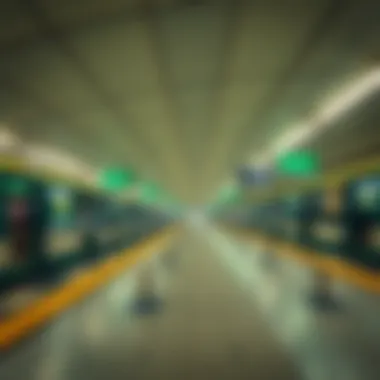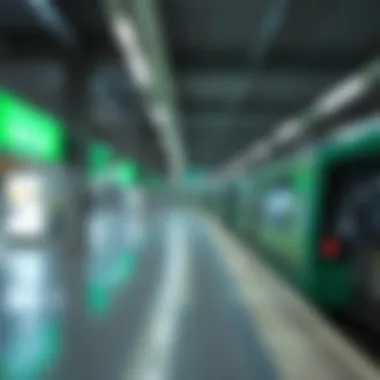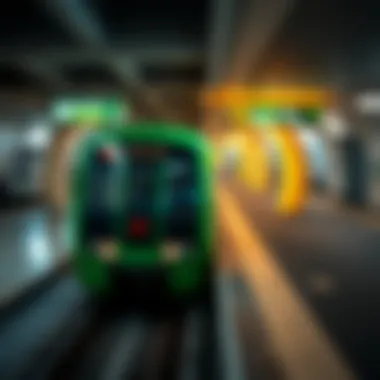Discovering the Green Line Metro Stations in Dubai


Intro
Dubai, a city of endless ambitions, continues to transform landscapes and redefine urban dynamics. At the heart of this transformation lies the Green Line Metro, a vital artery threading through the city’s rapidly expanding real estate and economic landscape. The Green Line is more than just a mode of transportation; it serves as a catalyst for growth, bridging gaps and connecting diverse neighborhoods with stunning attractions.
As we explore the Green Line Metro stations, we embark on a journey that reveals the interconnectedness of urban planning, investment opportunities, and cultural experience. Each station not only facilitates movement but also influences nearby real estate markets and shapes community interactions.
In this article, we will highlight pivotal aspects such as market trends related to the Green Line and investment opportunities that arise from it. We aim to provide a nuanced perspective for potential homebuyers, investors, and anyone keen on understanding how these stations contribute to the urban tapestry of Dubai.
Preamble to Dubai's Metro System
The Metro system of Dubai is more than just a means of transport; it's a lifeline for many residents and visitors alike. With its modern infrastructure and efficient design, the metro serves as a backbone for urban mobility in a city that has grown exponentially in recent years. While many people think of public transit primarily as a way to get from point A to point B, the implications of an advanced system like Dubai's Metro stretch far beyond mere convenience. It speaks volumes about the planning and foresight that has gone into shaping the city’s urban landscape.
The importance of the metro lies in its role in urban planning. By easing traffic congestion, it helps ensure a smoother flow of both people and goods throughout the city. Additionally, with stations strategically located near residential areas, commercial hubs, and cultural attractions, the metro significantly influences land use and real estate development. For investors and homebuyers, understanding the dynamics of the metro system can provide valuable insight into property value fluctuations as demand grows closer to metro stations.
The Role of the Metro in Urban Planning
Dubai's vision has always revolved around creating an interconnected city. The metro is central to this ambition. By offering a reliable and efficient alternative to traditional vehicular traffic, the metro helps minimize the environmental footprint of urban travel.
- Traffic Decongestion: One of the primary benefits of the metro is its ability to reduce traffic jams. Fewer cars mean less pollution and smoother travel.
- Increased Land Value: Areas surrounding metro stations often see a surge in property values, making them lucrative spots for both residential and commercial ventures.
- Multi-modal Transport Options: The metro also integrates well with buses and trams, providing seamless transfers that encourage public transport over personal vehicles.
In summary, the metro serves as a catalyst for sustainable urban growth, directly impacting how residents navigate the city and where they choose to live.
Overview of the Green Line
Launched in 2011, the Green Line is an essential component of Dubai's Metro network. Providing an east-west connection that complements the Red Line, it has become a vital artery for commuters.
The Green Line stretches over a significant distance, passing through several key neighborhoods and commercial districts:
- Length: Approximately 22.5 kilometers, linking riders to numerous crucial locations.
- Stations: With a number of strategically placed stations, the Green Line connects areas that were previously underserved, enhancing access to the metro system for a wider population.
- Design: Built with modern technologies, the stations are not only aesthetically pleasing but also incredibly functional, equipped to handle a high volume of passengers with ease.
The Green Line's development reflects Dubai's commitment to a progressive urban transit system, positioning itself as a model for other cities aiming for more environmentally conscious transportation solutions.
"A well-planned metro can be the compass guiding a city’s urban growth, enabling efficient movement and economic prosperity in harmony with its community's needs."
Key Features of the Green Line Metro
The Green Line of Dubai's Metro, though less extensive than its Red counterpart, possesses distinct features that play a crucial role in the city’s urban fabric. For investors, buyers, and anyone keen on Dubai's rising skyline, understanding the key features of this line is essential. From state-of-the-art design to user-centered accessibility, every element contributes to the seamless commuting experience and, notably, the adjacent real estate dynamics.


Innovative Design and Technology
When discussing the innovative design of the Green Line, it’s hard to overlook the striking aesthetic choices imparted in station structures and train designs. The architects have indeed crafted stations that echo the essence of modernism while embracing Dubai's cultural heritage. For instance, the use of glass and metal conveys both transparency and strength, emblematic of the city’s rapid development.
Moreover, the application of technology within the Metro system itself is impressive. Each station is equipped with digital screens offering real-time updates on train schedules, ensuring that passengers are always in the know. Not to mention the security measures, which utilize state-of-the-art surveillance systems for a safe travel environment. This blend of functionality and design aligns perfectly with Dubai's vision of becoming a global hub.
Key Features of Innovative Design:
- Sleek, modern architecture that enhances cityscape.
- Smart digital interfaces for easy navigation.
- Robust safety and security systems.
- Energy-efficient technologies integrated in construction.
This attention to cutting-edge design not only benefits daily commuters but also enhances the allure of nearby properties. As such, the proximity to the Green Line often factors into property valuations, appealing to investors who understand how innovation translates to real estate value.
Accessibility and User Experience
Accessibility is vital in any transportation system, and the Green Line stands out in this regard. With several disabled-friendly features, such as elevators, ramps, and tactile guidance systems, the stations ensure that all individuals, regardless of mobility level, can benefit from the Metro. This inclusivity aspect is a crucial selling point for those considering living near these stations.
The user experience extends beyond physical access; it's about how passengers feel throughout their journey. The spacious platforms are designed to handle high foot traffic, which mitigates crowding during peak hours. Waiting areas are also equipped with comfortable seating, allowing commuters to relax as they plan their next steps.
Key Considerations for Accessibility:
- Elevators and ramps for easy access.
- Clear signage and communication tools.
- Comfortable waiting areas.
- Efficient passenger flow design to reduce congestion.
In essence, the Green Line is more than just a transportation route; it's a strategic player in Dubai’s overarching urban strategy, intertwining accessibility with the potential for real estate development. Investors and homebuyers alike can appreciate the value adding capabilities of connectivity in shaping lively communities around these Metro stations.
"The Green Line isn't just about getting from point A to B; it's about journeying through a vibrant urban landscape."
Detailed Overview of Each Green Line Station
The Green Line of Dubai's Metro offers more than just a means of transport; it stands as a pivotal element in shaping the city's modern landscape. Each station along this route carries its own significance, contributing to the urban fabric of Dubai. By analyzing these stations, one can appreciate their role not only in daily commutes but also in enhancing property values and facilitating commercial growth. Understanding each station’s unique characteristics aids investors and homebuyers in making informed decisions in the vibrant market of Dubai.
Etisalat Station
Nestled amidst the bustling Al Qusais neighborhood, Etisalat Station is named after the prominent telecommunications company. This station serves as a nexus for commuters, connecting various residential areas while providing easy access to essential amenities. Its location near the Etisalat Headquarters can attract business professionals and tech-savvy individuals, enhancing demand for nearby properties.
The station itself boasts modern facilities, including ample parking and connectivity to multiple bus routes.
This connectivity adds a layer of convenience for those looking to integrate their travel with public transport, making it a center of mobility in the area.
Al Nahda Station


Al Nahda Station stands out due to its proximity to vibrant shopping destinations and recreational areas. Located close to the popular Sahara Centre, this station is a gateway for shoppers and families alike. The nearby residential communities benefit from easy access, ensuring a steady inflow of visitors.
Investors often eye this station due to the ongoing development projects around it. There is a growing interest in mixed-use developments that incorporate both residential and commercial units, capitalizing on the high foot traffic this station generates.
Al Qusais Station
Al Qusais Station is vital for its blend of residential and industrial zones. It provides crucial access to schools, workplaces, and leisure venues, making it a desirable area for families and professionals. The surrounding buildings reflect a mix of older establishments and newer high-rises, showcasing the area's evolution.
As the area matures, so does its real estate potential. Properties located near Al Qusais Station have been experiencing increased valuation, largely because of the improved connectivity and urban planning initiatives.
Dubai Airport Free Zone Station
Significantly positioned near the Dubai Airport Free Zone, this station primarily caters to business travelers and expatriates. It's strategically situated to allow seamless access to the airport, contributing to both economic activity and residential interest. The station is designed to handle increased traffic during peak hours, adapting to the demands of both commuters and visitors entering the free zone.
The proximity to international businesses creates a unique environment where potential homeowners or investors can capitalize on the continued growth of commercial activity. Greater investment in the infrastructure around this station is expected to solidify its importance in the future.
Jaddaf Station
Jaddaf Station is a rising star, surrounded by cultural institutions like the Dubai Culture Village, which host various art galleries and events. The station's design is aesthetically pleasing, matching the artistic vibe of its neighborhood. Moreover, the station serves as a critical link to the waterfront, providing chances for both leisure and commerce.
As this area garners more attention from tourists and locals, real estate near Jaddaf Station is becoming more appealing. The beauty of the location, combined with its cultural significance, positions it as a hotspot for investors looking for opportunities that blend heritage and innovation.
Rashidiya Station
Rashidiya Station marks the eastern terminus of the Green Line, making it a significant station for those traveling to and from the outskirts of the emirate. It is well-connected with nearby neighborhoods, offering access to schools, parks, and shopping centers. Its range of facilities ensures that it meets the needs of a diverse population.
With community development projects underway, Rashidiya Station plays a pivotal role in enhancing local connectivity. Properties in the vicinity are likely to appreciate as the area becomes increasingly integrated into the fabric of Dubai's larger transport network.
Each of these stations illustrates the multifaceted nature of the Green Line Metro, where urban connectivity aligns with real estate opportunities, catering to the needs of both residents and investors seeking to navigate Dubai's dynamic landscape.
Impact on Real Estate Development
The Green Line of Dubai's Metro isn't just a transit system; it's a key player in reshaping the city's real estate landscape. As one of the major arteries of transportation, the Green Line enhances connectivity, thereby influencing property values and investment prospects in the areas surrounding its stations. By opening new avenues for development, these metro stations are becoming a litmus test for future urban growth and planning in Dubai.
Proximity to Metro Stations and Property Values
When it comes to real estate, location is often the golden ticket. Properties located near metro stations typically see a significant uptick in value, and the Green Line is no exception. The ease of commuting can shift buyer interest dramatically, making neighboring areas much more appealing.


- Rising Demand: As more people flock to Dubai for work and leisure, the demand for housing near these stations has skyrocketed. Investors are recognizing that properties close to metro stops tend to attract long-term tenants and are less likely to remain vacant.
- Convenience Equals Value: Consider how accessibility influences buyer behavior. In today's fast-paced world, having quick access to public transport can be a deal-maker. Businesses also realize this; they often prefer locations near metro stations for retail and office spaces, knowing it can draw in foot traffic.
- The Ripple Effect: The presence of metro stations can rejuvenate surrounding neighborhoods. Outdoor cafes, parks, and shops pop up, contributing to a sense of community that enhances property values over time. Think of it as a domino effect—when one property value rises, it can have a knock-on effect on adjacent areas.
"Having a station nearby doesn’t just make life easier for residents; it turns neighborhoods into hot commodities for investors."
Commercial Opportunities Near Stations
With the rise of the Green Line, commercial opportunities are blossoming. Areas close to metro stations are turning into bustling hubs that attract a variety of businesses ranging from small shops to larger corporate offices.
- Retail Growth: Businesses that cater to a diverse clientele—ranging from commuters to locals—are increasingly opening up shop near the stations. Restaurants, convenience stores, and even tech startups view proximity to the metro as a strategic advantage.
- Increased Foot Traffic: High visibility is crucial, and stations provide this in spades. Entrepreneurs see greater foot traffic, which can lead to higher sales. The more convenient it is for potential customers to reach a business, the better the chances for extra revenue.
- Office Spaces: Companies are recognizing the need to be in accessible locations, and metro-adjacent office spaces are becoming the norm. This shift influences the type of developments that take place, with many opting for multi-use buildings that combine residential and commercial facilities.
Challenges and Future Prospects
The Green Line of Dubai’s Metro offers a tantalizing glimpse of what urban transportation can achieve, but it doesn’t come without its share of challenges and prospects for the future. Understanding these dynamics is crucial for stakeholders like investors, homebuyers, and developers. The state of the metro impacts various sectors, especially real estate, by determining accessibility and growth potential in various districts.
Operational Challenges Faced by the Green Line
Operating a metro system in a bustling city such as Dubai is no walk in the park. The Green Line faces a few significant operational hurdles, including:
- Capacity Management: As the population swells, the ridership on the Green Line is increasing. This uptick is putting pressure on train frequency and carriage capacity. How the authorities manage this surge will be critical for maintaining a smooth service. If commuters find themselves crammed like sardines during peak hours, it could deter usage.
- Technological Updates: Keeping technology up-to-date is another tough nut to crack. Modernizing signaling systems and maintenance protocols requires not just investments but also time. Outdated systems can lead to inefficiencies and safety risks, impacting rider confidence.
- Safety and Security: Safety is a top priority, especially in an area frequented by visitors from around the globe. Although there are stringent measures in place, any incident, large or small, could have ripple effects. Ensuring rider comfort is paramount for long-term patronage.
Effectively tackling these operational challenges will help the Green Line maintain its reputation as a go-to transport solution in Dubai.
Future Expansion Plans for the Metro System
Looking ahead, the future of the Green Line is bright, albeit with its challenges. Several expansion plans are on the table, reflecting Dubai’s ongoing commitment to enhancing its public transport:
- Adding New Stations: The Dubai Roads and Transport Authority (RTA) has announced plans to increase the number of Green Line stations. This increase aims to extend reach into new districts, making it easier for residents to connect with vital hubs, such as business districts and shopping centers.
- Integration with Other Transport Modes: Another exciting prospect is the enhancement of connectivity between the Green Line and other transport systems, including buses and water taxis. Improving these connections will create a more fluid urban transit experience, encouraging greater use of public transport.
- Sustainability Initiatives: The metro aims to go green by integrating sustainability measures. From solar energy at some stations to green spaces around them, the authorities are looking to reduce the carbon footprint of the metro system.
“Future expansions not only signify growth but also a promise to improve the quality of life for Dubai's residents.”
End
As we step back and reflect on the intricate framework behind Dubai's Green Line Metro, it becomes clear that its impact extends far beyond mere transportation. This system serves as a backbone for urban connectivity, reshaping not just the way residents and visitors traverse the city but how they relate to their own neighborhoods and communities. The Green Line encapsulates a vision of modern urban planning, one that embraces accessibility and efficiency while also paying homage to the need for a sustainable future.
Final Thoughts on the Green Line's Contribution to Dubai
The Green Line's significance in Dubai can be viewed from multiple angles, each revealing a layer of its vast influence:
- Enhancing Urban Mobility: The Green Line facilitates a seamless experience for commuters, reducing congestion and travel time. This ease of mobility makes attractions such as Al Qusais and Rashidiya not just accessible, but also appealing for potential investors and residents looking to enjoy Dubai's vibrant lifestyle.
- Boosting Real Estate Development: Properties located close to Metro stations often experience appreciation in value. As developers recognize the appeal of residential areas near these stations, they begin to create new spaces that reflect modern necessities – think of community parks, pedestrian walkways, and commercial zones.
- Economic Growth: By connecting key areas of the city, the Green Line acts as a catalyst for economic development. It not only drives more foot traffic to local businesses but also encourages new ventures to set up shop in vibrant, transport-linked locations.
- Sustainability Goals: In a region where driving is often the default option, the Metro offers clean, energy-efficient travel. Investing in green infrastructure is crucial for Dubai’s future as it works towards its sustainability targets.
It's essential for potential homebuyers, investors, and even expatriates to realize that the Green Line is a hallmark of a city in continuous evolution. With future expansions on the horizon, this Metro line will surely continue to shape Dubai’s urban landscape, attracting more crowds and enlightening prospects of a dynamic commercial environment.
"The Green Line is not just a route; it's a lifeline connecting communities and fueling Dubai's economic pulse.”
Together, the elements of accessibility, economic potential, and sustainable development intertwined with the Green Line promise a future that resonates with opportunity and connectivity. This multi-faceted public transport system is undoubtedly a cornerstone of Dubai’s ambitious urban narrative.







